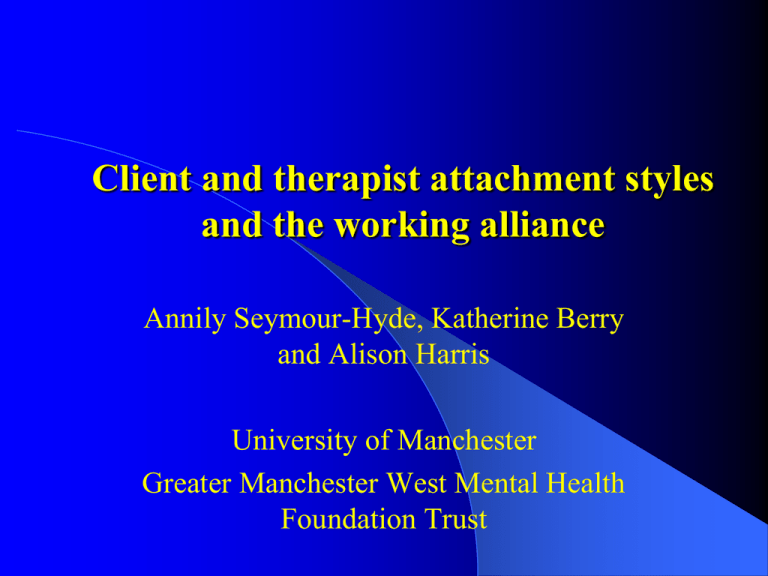Katherine Berry annietalk
advertisement

Client and therapist attachment styles and the working alliance Annily Seymour-Hyde, Katherine Berry and Alison Harris University of Manchester Greater Manchester West Mental Health Foundation Trust Background Well-established association between therapeutic alliance and outcome (Horvath et al., 2011). Hence search for predictors of alliance, including both therapist and client characteristics. Limited evidence of the role of demographic factors. Stronger evidence for interpersonal characteristics (Beutler et al., 1994; Norcross, 2011). Background Attachment theory is an interpersonal theory which has relevance across the life span (Bowlby, 1980). Earlier interpersonal experiences influence interpersonal functioning and methods of regulating distress in adulthood via attachment working models. Responsiveness and sensitivity of caregiving experiences in infancy is hypothesised to be key in determining security in adulthood relationships. Bartholomew’s model Positive (Low) Positive (Low) MODEL OF SELF (ANXIETY) Negative (High) SECURE PREOCCUPIED High self-worth, believes that others are responsive, comfortable with autonomy and in forming close relationships with others. A sense of self-worth that is dependent on gaining the approval and acceptance of others. MODEL OF OTHER (AVOIDANCE) Negative (High) DISMISSING FEARFUL Overt positive self-view, denies feelings of subjective distress and dismisses the importance of close relationships. Negative self-view, lack of trust in others, subsequent apprehension about close relationships and high levels of distress. Background Insecure attachment patterns may be adaptive in the context of sub-optimal earlier environment. But they are: - associated with psychopathology in adulthood, including anxiety and depression (e.g. Williams & Riskind, 2004). - have a negative impact on the psychotherapy process, including willingness to seek help (e.g. Dozier, 1990), therapeutic alliance (Daniel, 2006) and outcomes (Schauenburg et al., 2010). Background Modifying client attachment patterns has therefore been conceptualised as a key goal of therapy (e.g. Mallinckrodt et al., 2010). Bowlby’s (1988) idea of the ‘secure therapeutic base’ and the ‘corrective emotional’ experience. Capacity to care for others and provide a secure base is likely to be influenced by own attachment style and there is evidence of transmission of attachment patterns across generations (van Ijzendooran, 1995). Background Some evidence suggests that therapist attachment security influences therapeutic alliance and outcome, particularly in more complex cases (e.g. Schauenburg et al., 2010) But this isn’t straightforward, as there is evidence for an interaction effect between therapists’ and clients’ attachment patterns with ‘mismatches’ being associated with better alliances and outcomes (e.g. Tyrell et al., 1999; Bruck et al., 2006). Aims and hypotheses To investigate associations between client and therapist attachment styles, including interaction effects in routine mental health therapy services. We predicted associations between both client and therapist secure attachment and better alliance scores. We predicted associations between both client and therapist insecure attachment and poorer alliance scores. We predicted that a mismatch between client and therapist attachment scores would be associated with better alliance scores. Method Participants - 30 therapist-client dyads. - Recruited from primary care psychology services in the North West. Measures - Relationship Questionnaire (Bartholomew & Horowitz, 1991) - Working Alliance Inventory (Horvath & Greenberg, 1989) - PHQ-9 and GAD-7 Results Hypothesis: Associations between client attachment and alliance Client-rated Therapist-rated alliance alliance Client secure .25 (.176) .12 (.541) Client fearful -.17 (.384) -.05 (.790) Client dismissing Client preoccupied -.08 (.678) -.19 (.32) -.12 (.518) -.19 (.315) Results Hypothesis: Associations between therapist attachment and alliance Client-rated Therapist-rated alliance alliance Therapist secure -.13 (.494) -.05 (.796) Therapist fearful -.17 (.375) -.07 (.670) Therapist dismissing Therapist preoccupied .06 (.744) .11 (.252) -.08 (.667) -.13 (.422) Results • Post hoc analysis controlling for influence of client complexity. - Therapist fearful attachment was significantly - associated with client-rated alliance in more complex clients (r = -.63, p = .016), but not in low complex clients (r = .33, p = .207). Therapist preoccupied attachment was significantly associated with therapist-related alliance in more complex clients (r = -.80, p = .853), but not in low complex groups (r = .14, p = .583). Results Hypothesis: A greater ‘mismatch’ between client and therapist attachment scores will be associated with better alliance scores Preoccupied match score Dismissing match score Client-rated alliance .05 (.778) Therapist-rated alliance .43 (.018) .41 (.024) -.10 (.597) Summary and discussion Lack of associations between both client and therapist attachment and alliance. Mixed findings in relation to client attachment and alliance, particularly insecure attachment types (Smith et al., 2010). Attachment to therapist may be more important than global attachment style (e.g. Mallinckrodt et al 2005). Mixed findings in relation to therapist attachment and alliance. Summary and discussion Many studies finding associations between therapist attachment and alliance sample therapists in training or relatively inexperienced therapists (e.g. Dunkle & Friedlander, 1996). More experienced therapists may be more selfreflective and use supervision to counteract the potentially negative influence of their insecure attachments. But insecure therapist attachment styles may have a negative effect on alliance in more complex cases (also see Schauenberg et al., 2010). Summary and discussion Another possible explanation for mixed findings in relation to client and therapist attachment and alliance is interaction effects. Consistent with Tyrell et al’s (1999) research with case managers, discrepancies in dismissing and preoccupied attachment were associated with better alliances. Although there were differences between client and therapist ratings of alliance, highlighting the importance of considering both. Clinical and research implications Importance of considering therapist experience and investigating how therapists can develop and use knowledge of their own attachments styles in therapy. Importance of considering client complexity and the possibility that therapist’s own insecurity may have more influence in complex cases. Importance of considering interaction between therapist and client attachment in clinical work. Clinical and research implications The potential benefits of mismatching. But engagement and working phases of therapy (e.g. Mallinckrodt, 2000; 2010). Importance of assessing alliance from both clients’ and therapists’ perspectives in both clinical practice and research. Contact Katherine.berry@manchester.ac.uk







